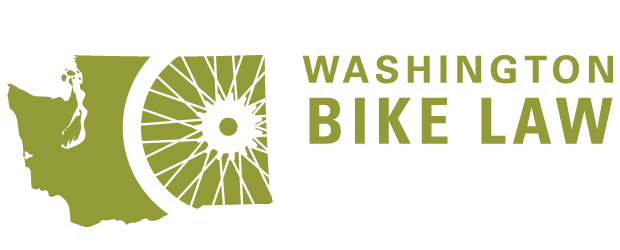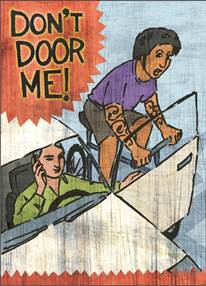Bicycles on Sidewalks in Washington State and Finding the Law in Washington
Many people believe that bicyclists shouldn’t ride on sidewalks; but the legality of this act is not based upon people’s opinions, no matter how loudly they yell them at us.
Whether or not we can legally ride a bicycle on a sidewalk depends upon where that sidewalk is. Even if riding a bicycle on a sidewalk is illegal in a particular city, motor vehicle drivers must yield to bicyclists on sidewalks everywhere in Washington. The Revised Code of Washington states:
The driver of a vehicle shall yield the right-of-way to any pedestrian or bicycle on a sidewalk. The rider of a bicycle shall yield the right-of-way to a pedestrian on a sidewalk or crosswalk. (RCW 46.61.261(1))
In Seattle, a bicyclist may ride on any sidewalk in a “careful and prudent manner.” A bicyclist may ride “at a rate of speed no greater than is reasonable” for the conditions and must also “yield the right-of-way to any pedestrian thereon, and shall give an audible signal before overtaking and passing any pedestrian.” (Seattle Municipal Code 11.44.120)
In Bellevue, bicyclists can also ride on any sidewalk, however, “when because of the width of such sidewalk or the amount of pedestrian traffic thereon” riding would “unreasonably inconvenience pedestrians”, riders must “stop and dismount”. (Bellevue Municipal Code 11.60.070)
Bellevue bicyclists, like those in Seattle, also have the duty to yield the right-of-way to pedestrians on sidewalks and must give an “audible signal before overtaking and passing any pedestrian.” (Bellevue Municipal Code 11.60.080)
Some municipalities have drafted their own laws regarding bicycling on sidewalks, but many more follow the Washington Model Traffic Ordinance (WAC 308-330). The Model Traffic Ordinance is woefully out of date. It fails to address many newer bike facilities and results in confusion for everyone on the road. Washington Bike Law is working to update it.
Currently, the Model Traffic Ordinance provides the following law for bikes on sidewalks:
(1) No person shall ride a bicycle upon a sidewalk in a business district.
(2) A person may ride a bicycle on any other sidewalk or any roadway unless restricted or prohibited by traffic control devices.
(3) Whenever any person is riding a bicycle upon a sidewalk, such person shall yield the right of way to any pedestrian.
(WAC 308-330-555) Unfortunately, many smaller towns that use the Model Traffic Ordinance don’t define where their business district is.
The municipal codes for most cities in Washington can be found on a website run by the MRSC. Once there, it’s easy to find the city or town you want, but more difficult to find the relevant code. If you can find it, you’ll may need to jump back and forth with the Model Traffic Ordinance to see what parts the municipality has adopted.
For instance, to find the law in Spokane, MRSC links to the Spokane Municipal Code. The law for bicycles on sidewalks is in the Motor Vehicles section. This references the Model Traffic Ordinance.
You need to know that WAC 308-330-555 is the Model Traffic Code for bikes on sidewalks to make sense of Spokane’s Sections Not Adopted. Spokane did not adopt WAC 308-330-555.
So, we go back to the Motor Vehicles section of the code and to Rules of the Road. Bingo! Spokane spells it all out in Section 16A.61.787 Sidewalk Riding and Parking Regulated:
- No person may ride a bicycle or non-motorized vehicle upon any sidewalk or other pedestrian way within the retail zone of the congested district of the City as defined by SMC 16A.04.010 and SMC 16A.04.020 , provided that nothing contained herein shall be construed to prohibit the riding of a bicycle or non-motorized vehicle upon any sidewalk or other pedestrian way within any area other than the retail zone of the congested district of the City.
- Whenever any person is riding a bicycle or non-motorized vehicle upon a sidewalk or other pedestrian way of the City, the persons shall yield the right-of-way to all pedestrians and shall give an audible signal before overtaking and passing any pedestrian.
- Whenever any person is riding a bicycle or non-motorized vehicle upon a sidewalk or other pedestrian way of the City, the person shall at all times exercise due care to avoid colliding with any pedestrian and shall operate the same in a careful and prudent manner and at a rate of speed no greater than is reasonable and proper under the conditions existing at the point of operation, taking into account the amount and condition of surface. When, because of the width of the sidewalk or other pedestrian way or the amount of pedestrian traffic thereon, riding a bicycle on the sidewalk or other pedestrian way would endanger or unreasonably inconvenience pedestrians, the person shall stop and dismount from the bicycle.
- No person shall place a bicycle or non-motorized vehicle upon a sidewalk or other pedestrian way in a manner as to obstruct reasonable pedestrian traffic and/or vehicular traffic emerging from alleys or driveways.
- "Non-motorized vehicle" means any wheeled vehicle for transporting a person which is not propelled by a motor or engine, including skateboards, roller skates, in-line roller blades or coasters. This does not apply to wagons, strollers, wheelchairs or assisted transportation devices.
- This section does not apply in Riverfront Park or to the Centennial Trail.
- This section does not apply to law enforcement personnel patrolling on bicycles.
Now let’s compare Tacoma’s law to Spokane’s. MRSC links to Tacoma’s municipal code here. Tacoma’s actual code is here. Then, we need to find the law for sidewalks… is it Police, Public Safety, Public Ways, or Traffic? Let’s try Traffic… oh, we’ve downloaded a PDF.
Chapter 11.05 of the Tacoma Municipal Code references the Model Traffic Ordinance. Scrolling down, it looks like the PDF switches orientation several times. TMC 11.05.020 (which is upside down) tells what sections are not adopted. So, assuming that we know that WAC 308-330-555 is the Model Traffic Code for bikes on sidewalks, we can deduce that, since it isn’t listed as not adopted, that Tacoma follows it. Easy right?
Well, now the question is whether this Tacoma sidewalk was in a business district. Would this be in the Public Ways section? 60 pages and no mention of “business district”. How about Land Use Regulatory Code? 566 pages and no matches. Is that it?
Since Tacoma doesn’t seem to define “business district” we can’t tell from the Tacoma Municipal Code whether or not riding on the sidewalk is allowed if no signs forbid it.
So, how can we figure out what a “business district” is in Tacoma if it’s not in the Tacoma Municipal Code? There are two basic types of laws: statutory law and common law.
Laws passed by the legislative branches of government are arranged in a relatively organized way using numbered codes and regulations. However, we are also governed by the common law, which is based upon historical decisions by judges.
While judicial decisions are increasingly available on the web, including the MRSC, obtaining and, more importantly, understanding legal decisions is difficult.
Using the common law is a bit like writing a book report in high school. Except, instead of interpreting one book, we use pieces of multiple judicial decisions to argue a legal issue. Lawyers (whether they admit it or not) read the decisions and look for language that supports their arguments. Some people are better at this than others.
And this is why, despite the many lawyer jokes with some basis in reality, people with serious legal issues ought to consult with a lawyer experienced in the area at issue rather than guessing at the law.
Washington Bike Law provides free legal consultations, so there’s no reason to guess. Just ask us. We are happy to help.
Bob Anderton is the founding attorney at Washington Bike Law. Bob can be reached at (206) 262-9290 or bob@washingtonbikelaw.com.

This work is licensed under a Creative Commons Attribution-NonCommercial-NoDerivatives 4.0 International License.

